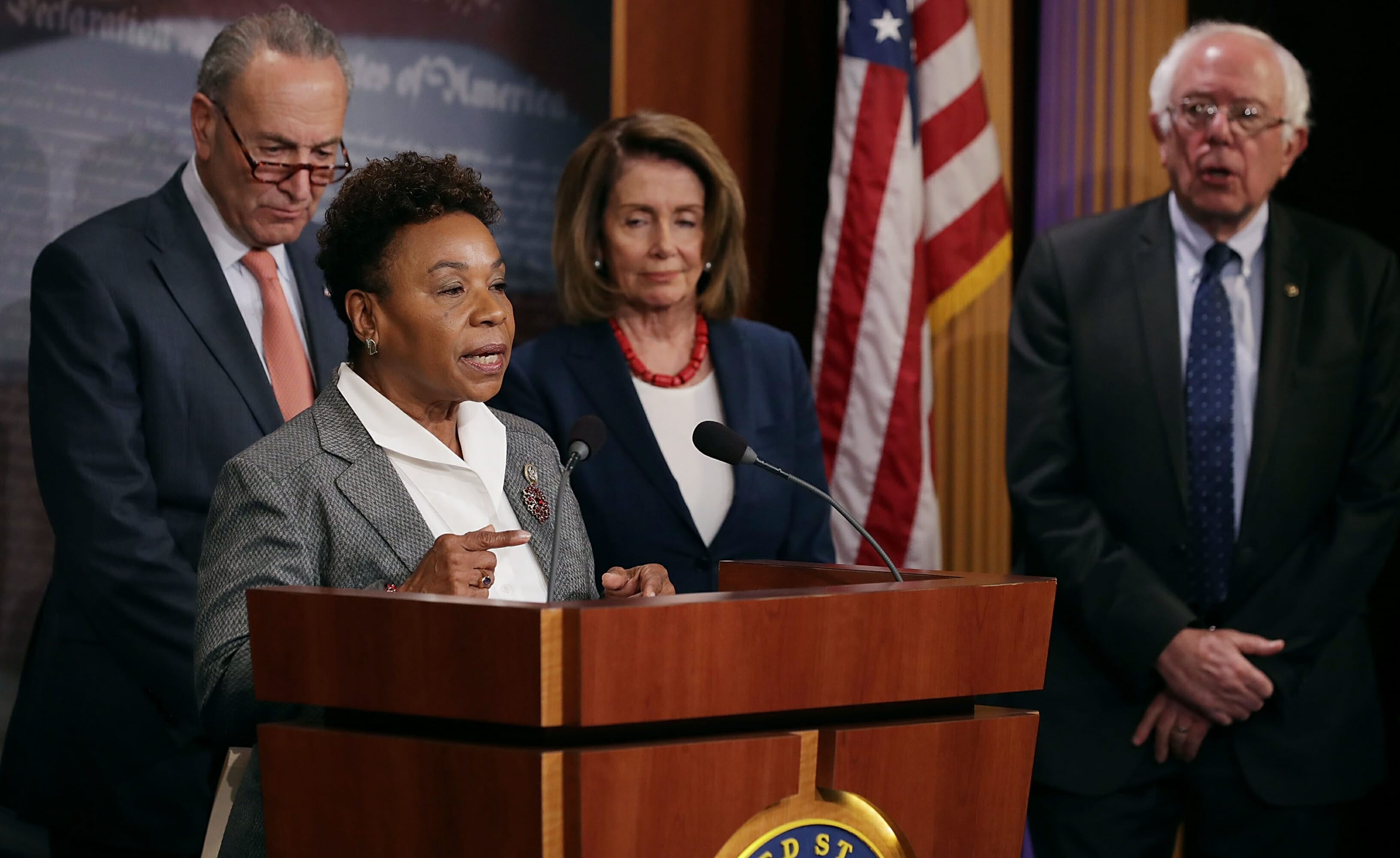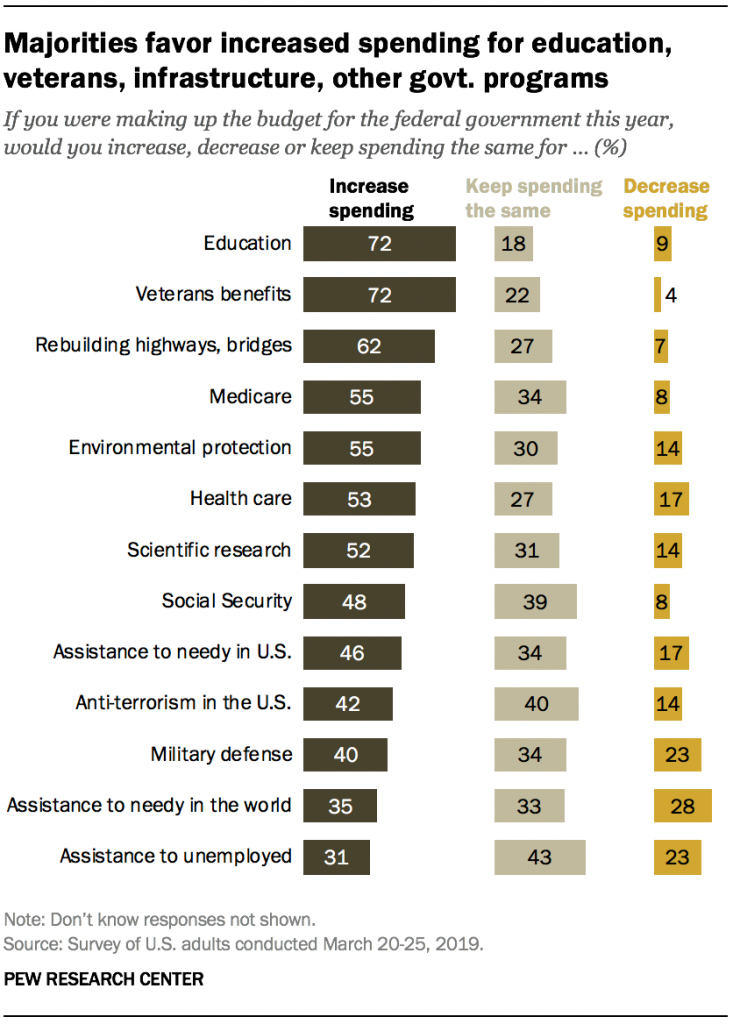These Are America’s Three Major Political Parties
Photo by Chip Somodevilla/Getty
“However [political parties] may now and then answer popular ends, they are likely in the course of time and things, to become potent engines, by which cunning, ambitious, and unprincipled men will be enabled to subvert the power of the people and to usurp for themselves the reins of government, destroying afterwards the very engines which have lifted them to unjust dominion.” — President George Washington in his 1796 farewell address.
If you submitted a paper predicated upon the traditional American view of political ideology in a political science 101 class, it would fail. The image of American politics communicated to us by our political and media establishment is that we all operate upon one ideological axis, with the Democratic and Republican Parties representing the left and right side of the ideological spectrum.
As any freshman political science student can tell you, political ideology is typically measured upon both an X and Y axis, because not all political beliefs are the same and therefore need different kinds of measurements (the fact this needs to be said is a good indication of how distorted the traditional framing of American politics is). This distorted left-right spectrum attempts to cram both an economic and social ideology into one unified front, when all available evidence tells us that is simply not how human political ideology works. A big part of America’s political dysfunction is the fact that we have two political parties representing far more than two political factions. These two political parties have had a bipartisan compromise on many economic issues for decades—mostly to the benefit of our biggest economic institutions like the insurance, oil and defense industries.
Where the parties wildly differ is on social issues, as this week’s fight over Trump’s racist tweets demonstrated. That is the split in American politics, and it is telling of the priorities of the party that many “establishment” Democrats maximize their messaging on social issues, while tacking to the center on economics. According to this study of the 2016 electorate by the Voter Study Group, pretty much all liberals broadly agree on both social and economic principles, and somewhere around half of Republicans could be defined as economically liberal.
https://t.co/I2PePHWenxpic.twitter.com/4ZkBlcou0j
— Best Posts (@onlygoodposts1) February 4, 2019
This study demonstrates how there are (roughly) three major voting blocs in America. The heavy concentration of blue dots in the bottom left hand corner prove the existence of a very large consensus on both staunchly liberal/leftist economic and social policy (44.6% according to the study). That is the base of the Democratic party. The heavy concentration of red dots at the north end of the Y axis are the socially conservative “red meat” base of the GOP. The small cluster in the middle four squares are moderates, and you can see that they disproportionately vote red instead of blue. The absolutely threadbare bottom right quadrant is where you will find the actual socially liberal and economically conservative folks. The fact that the most popular political self-classification in America has very little ideological representation in the 2016 electorate should be a giant flashing red light alerting us to the con being played on everyone by America’s uniquely distorted political spectrum.
Republican Party
While the Democrats like to refer to themselves as the “big tent party,” this study proves that the GOP has a far more robust concentration of voters occupying a wider swath of the ideological spectrum than the Dems do. It’s hard to remember given the speed with which news moves these days, but before Trump was elected, it seemed as if the GOP was going to tear itself apart at the seams any minute. The Republican electorate is staunchly tilted in favor of Trump’s brand of white nationalism, and it is split roughly 50-50 along economic lines. You wouldn’t know this from their libertarian economic platform, but the GOP has some very liberal economic views hidden within it.
A majority of Republican voters approve of Medicare for All. Millennial Republicans, a not insignificant voter bloc, largely disapprove of socialism, save for 29% who approve of it. That may seem low, but that is roughly 8.3 million Republican voters who are sympathetic towards socialism. To put that in context, Hillary received 2.8 million more votes than Trump in 2016. It’s not just millennial Republicans who harbor liberal views either; this poll from Pew proves how little appetite there is to cut government programs across the board, demonstrating that Republican voters on the whole are far more economically liberal than Republican politicians.
This is not expressed in their politics, because a Trump vote demonstrates that their economic views are secondary to backing the racist view of America he espouses (and because the entire infrastructure of the GOP is a wholly owned subsidiary of America’s billionaire oligarchs who fuel this racist fire because they benefit the most from authoritarian politics). If the Democratic Party was truly committed to an accurate representation of its “bipartisan” goals, socialized medicine would be front and center among the Democratic Party elite’s policy platform, and they would win far more Republican votes because of socialized medicine than one would be led to believe given the “left-right” distortion that our politics creates. But alas, they do not.
Democratic Party
The Democratic Party also has significant portions of its infrastructure owned by America’s billionaire oligarchs, and that is the root cause of the fights that demoralized so many of us this past week. This evidence is anecdotal, but even a couple of my non-politically brain poisoned friends (a blessing, truly) asked me why the party was spending so much energy attacking Alexandria Ocasio-Cortez when Trump is in the White House. It is demoralizing to hear time and time again that my ideology, represented by four of the bravest women in all of America today (and a caucus making up 41.7% of the Democratic House), should come secondary to the wishes of people who can still be persuaded to vote for a man separating children from their parents and putting all of them in concentration camps.
But back to party politics: what’s really fueling this fight against AOC is the movement behind her, politically organized by Justice Democrats—who are primarying Democrats in safe seats—with corporate money being one of the central issues in every single one of these challenges to longstanding Democratic power. Alexandria Ocasio-Cortez fired the first successful shot in this war, taking down one of the most powerful members of the New York Democratic machine (a machine so powerful it clearly can operate independent of the control of the Speaker of the House), and an entire generation of Democrats whose career was built on gerrymandered victories are now freaking out that their jobs are finally being called into question.
AOC doesn’t take corporate money because she doesn’t need it. The Representative from the Bronx just raised $1.2 million in the second quarter. For context, presidential candidate and former Senate candidate Beto O’Rourke just raised $3.6 million in the second quarter. Most Congressional Democrats simply do not need corporate money. Sure, there are certain seats in major media markets where small dollar donations would not be enough to run a successful campaign, so it is understandable for some seats to be exempt from this rule, but AOC, and now Elizabeth Warren with her massive $19 million 2nd quarter haul, have proven that most of the Democratic Party can survive without corporate donors. Justice Democrats have announced that they will primary Democrats in safe seats over the issue of taking money from the billionaires who are looting our republic, and a certain stripe of careerist Democrat has decided to follow the centuries-long corrupt New York machine into war with the new left.
A major reveal in that chart from the Voter Study Group above is that there are not a whole lot of 2016 Clinton voters who are super jazzed about taking corporate money and helping billionaires out. It may seem like there are wide ideological gulfs on the left, but there really are not. What we have on the left is a war over a vision of power that largely falls along generational lines, and how we should treat our elected officials. The Democratic Party itself—as an ideology represented by the “bipartisan middle” so beloved by longtime establishment politicians like Joe Biden and Chuck Schumer—has very little ideological representation within the electorate. As you can see on the chart, it is also inundated with splotches of red 2016 Trump votes, and herein lies the problem.
The Liberal/Leftist Party
This is the biggest ideological coalition in America and it has the least amount of representation in government (by design). For all the talk of socialism versus capitalism, when we strip ideology down to its bare parts, we see that Americans agree a lot on both basic social and economic politics, and our politics is liberal. It is not center-left, nor center-right, but the debate begins at liberal and the only question is how far left it stretches. This is where the largest bipartisan compromise takes root, as you have to go about halfway up the socially conservative Y axis before you find more 2016 economically liberal Trump voters than Clinton ones. In fact, in the “socially liberal but economically conservative” barren quadrant closest to the center of the chart so beloved by establishment Democrats, there are seemingly as many “other” voters as 2016 Clinton voters.
Which is to say that we in the majority party are being sold a lie by an ideological minority controlling the Democratic Party—a minority which often finds itself in policy alliance with the oligarchy choking the life out of our democracy. The fights of the past week were of power lashing out at being challenged, which highlighted this longstanding split in the Democratic Party that has only widened since the humiliations of the 1970s and 1980s. When Bill Clinton won the presidency in 1992, declaring that “the era of big government is over,” the Democrats effectively adopted a diet version of Reaganism, and what we are currently witnessing over the fights of “socialism” is a new generation rejecting the politics of their parents’ adulthood, and embracing the politics of their parents and grandparents’ youth.
![]()
This upcoming election is scary. I thought about election night 2020 the other day and simply froze with fear. It is perfectly understandable to prioritize exhuming the White House of its orange goblin infestation first and foremost in the 2020 Democratic primary. The problem is that the notion of “electability” is a lie peddled to us by an establishment uninterested in pivoting from our modern Gilded Age. Do not fall for it this time around. Polls show that every Democrat currently polling above the margin of error can beat Trump.
American politics eliminates the Y axis, and it’s difficult not to agree with George Carlin and assert that it is because the powers that be agree on a libertarian economic ideology that the vast majority of Americans reject, therefore the oligarchy must impose this ideology through quiet authoritarianism, all while giving us what Carlin called the “illusion of choice.” A central part of our politics has been stripped away from us, and we have been left to fight largely over tribalism, while a handful of billionaires loot our coffers as Rome burns. Americans are largely united over what kind of economic policies need to be implemented, but what we lack is a political establishment willing to undertake the gargantuan tasks we have been putting off for a half-century (at least).
This country was built on the foundation of white supremacy. Our economic supremacy would not be possible without the institution of slavery, and its increasingly watered-down authoritarian descendants (an institution America had for slightly less time than women have had the right to vote, I might add). Our cultural squabbles are tied up in our economic squabbles, and while they are inextricably linked, they both require specific policy attention in order to ameliorate the economic and bigoted inequality that has always been built into the constitutional fabric of this nation. That is the consensus upon which the bottom left quadrant is built—the largest consensus in the 2016 electorate—and the least represented ideology in American government today.
The Democrats are led by an elite more interested in the dollars propping up the “right” than the votes propping up the “left.” This simmering fight has begun to reach a boil, as the leftist fights from the 1930s and 1960s have received massive reinforcements in the form of the two biggest and most liberal generations in American history. Any analysis which presumes “socialism” to 100% be a liability for a candidate simply erases an extremely liberal plurality of the electorate. Times have changed. So should our strategy.
The evidence for why George Washington warned us of the dangers of political parties in his farewell address is all around you. Our allies in Europe have lots of political parties now, because the logical conclusion of Washington’s words about the horrors of centralized, unaccountable representative power is the short story of the last few centuries of European history. We are a young country founded by Europeans currently repeating the mistakes of Europe’s past, and our current centralized oligopolist oligarchy is what Washington tried to warn us about.
I will admit that saying we have three political parties is something of an over-simplification—as political reality is closer to France’s model where there are roughly eight parties, and no one receives more than about a quarter of the vote in the first round of elections—but when it comes to the big debates about American government, there is a broad consensus on a lot of topics, especially economics. The 2016 voting bloc seems to fall into three major ideologies: blood and soil white nationalism, liberally economic and socially conservative thinking, and staunch liberalism in all directions.
According to this Voter Study Group analysis of the 2016 electorate that every single political reporter should read, just 3.8 percent of voters actually had economically conservative and socially liberal beliefs. The reverse is where the swing votes truly lie, as 28.9% hold economically liberal views and socially conservative ones, and a lot of those folks voted for Clinton in 2016.
The smallest of these three powerhouse voting blocs is indicative of Trump’s base: 22.7% of the electorate. It is simply not true that we need to move right on economics in order to court the most amount of voters. Most voters are to the left on economics, and the ones who can still be compelled to vote for a white nationalist in 2020 should not be people who we spend time and resources on in trying to bring into our coalition. America needs more political parties, but for now, the Democratic Party is all we’ve got, and we need them to understand this fundamental reality about U.S. politics if we are to win in 2020.
If it is true, as Republicans and their president this week have asserted, that criticizing our current government for not being for, by and of the people is un-American, then they are declaring that our stated ideals are hogwash and King George’s monarchy was right after all. This is what we are up against in the next election, and if the Democratic Party tries to woo the roughly 5% of the electorate that is actually economically conservative and socially liberal over trying to run up the score among the ~45% of staunch liberals while capturing some votes from the ~30% who are economically liberal and socially conservative, then the only logical conclusion is to heed our founding father’s words, and dismantle an institution which clearly causes more harm than good.
Jacob Weindling is a writer for Paste politics. Follow him on Twitter at @Jakeweindling.









































